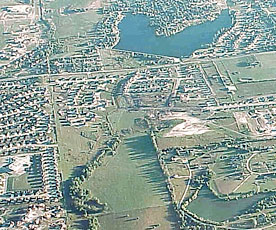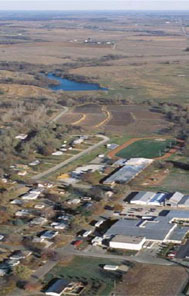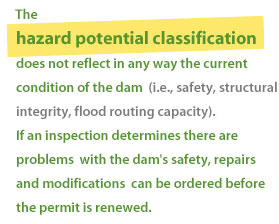About EAPs
What is a High-Hazard Potential Dam?
Each state has definitions and methods to determine the Hazard Potential of a dam. The Hazard Potential is defined as a situation which creates the potential for consequences such as loss of life, property damage, or other adverse impacts.
 Neighborhood association dams in suburban communities can be a significant risk to downstream residents and their homes, workers and their businesses, and even those who may be merely passing through the area.
Neighborhood association dams in suburban communities can be a significant risk to downstream residents and their homes, workers and their businesses, and even those who may be merely passing through the area.

Extensive development downstream from dams in rural areas will increase the risk to lives and property in the event of a dam failure.
These adverse impacts may occur in a defined area downstream of a dam because of flood-waters released through spillways and outlet works of the dam or because of waters released by partial or complete failure of the dam. Adverse impacts also may occur upstream of the dam from effects of backwater flooding or landslides around the reservoir perimeter.
In Indiana, dams are regulated by the Department of Natural Resources (DNR) if they meet any one of the following criteria: (1) the drainage area above the dam is greater than 1 square mile, (2) the dam embankment is greater than 20 feet high, or (3) the dam impounds more than 100 acre-feet. The height of a dam is from the highest point on the crest of the dam to the lowest point on the downstream toe, and the storage capacity is the volume impounded at the elevation of the highest point on the crest of the dam. (See this website's glossary for further terms and definitions.)
Dam Safety Program engineers determine the "hazard potential" of a dam, meaning the probable damage that would occur if the structure failed, in terms of loss of human life and economic loss or environmental damage. As defined by Indiana law, hazard classification means a rating assigned to a structure by the DNR based on the potential consequences resulting from the uncontrolled release of its contents because of a failure or wrongful operation of the structure. Indiana currently places all dams into one of three hazard classifications:
- High hazard: A structure the failure of which may cause the loss of life and serious damage to homes, industrial and commercial buildings, public utilities, major highways, or railroads.
- Significant hazard: A structure the failure of which may damage isolated homes and highways, or cause the temporary interruption of public utility services.
- Low hazard: A structure the failure of which may damage farm buildings, agricultural land, or local roads.
 The classification of dams can be changed if the hazard potential has changed. Flood plain zoning and early warning systems may be considered in making this determination. When dams are spaced so that the failure of an upper dam would likely cause failure of a lower dam ("cascading"), the consequence of the lower dam's failure determines the upper dam's hazard classification. In situations where a bridge or roadway is the only damageable property below a dam, hazard classification may be based on the possibility of loss of human life, indirect economic impact through loss of service, and direct cost of damage to the bridge or roadway.
The classification of dams can be changed if the hazard potential has changed. Flood plain zoning and early warning systems may be considered in making this determination. When dams are spaced so that the failure of an upper dam would likely cause failure of a lower dam ("cascading"), the consequence of the lower dam's failure determines the upper dam's hazard classification. In situations where a bridge or roadway is the only damageable property below a dam, hazard classification may be based on the possibility of loss of human life, indirect economic impact through loss of service, and direct cost of damage to the bridge or roadway.
A property owner, the owner's representative, or an individual who resides downstream from a dam may request in writing that DNR declare the dam to be a high-hazard structure if they believe that the dam failure would cause a loss of life or damage to their home, building, utility, major highway, or railroad. If DNR receives such a request, engineers will investigate the dam and area downstream, notify the dam owner of the investigation, and make a determination as to whether the dam is a high-hazard structure. If DNR determines that the dam is a high-hazard structure, all corresponding regulatory requirements will apply. The dam will also be placed under DNR jurisdiction if it was not before the determination.
| DAMAGE TO: | AREA AFFECTED BY DAM BREACH | ||
|---|---|---|---|
| LOW | SIGNIFICANT | HIGH | |
| LOCATION | Rural or Agricultural Damage would be minimal and would mostly occur on dam owner's property. No building, road, railroad, utility, or individual significantly affected. Damage is limited to farm buildings, agricultural land, and local roads. |
Predominantly Rural or Agricultural but roads, buildings, utilities or railroads may be damaged. | Developing or Urban Where individuals could be seriously injured or killed. Buildings, roads, railroads or utilities seriously damaged. |
| POTENTIAL LOSS OF LIFE Flood depths greater than 1 foot in occupied quarters. Potential of loss of human life may occur. |
No | No | Yes |
| ROADS County roads, state two-lane highways. or U.S. highways Serving as the only access to a community. Multilane divided state or US highway, including an interstate highway. |
No Damage | May Damage Interruption of service for not more than 1 day. |
Serious Damage Interruption of service for more than 1 day. |
| RAILROADS Operating Railroads |
No Damage | May Damage Interruption of service for not more than 1 day. |
Serious Damage Interruption of service for more than 1 day. |
| OCCUPIED QUARTERS Homes-Single family residences, apartments, nursing homes, motels and hospitals |
No Damage | May Damage Damage that would not render the structure unusable |
Serious Damage Damage where the flow velocity at the building compromises the integrity of the structure for human occupation. |
| UTILITIES | No Damage | May Damage Damage may occur to important utilities where service would not be interrupted for more than 1 day but either of the following may occur: 1) buried lines can be exposed by erosion, or 2) towers, poles and above ground lines can be damaged by undermining or debris loading. |
Serious Damage Interruption of service to interstate and intrastate utility, power or communication lines serving towns, communities or significant military and commercial facilities in which disruption of power and communication would adversely affect the economy, safety, and general well-being of the area for more than 1 day. |
Indiana dam safety regulations specify that in classification of dam hazard potential, development within the "maximum breach inundation area" will be considered. This is defined as the downstream area that would be affected by flooding from an uncontrolled release (dam failure) of a dam's contents when:
- The impoundment is at maximum design pool elevation;
- The downstream area is flooded from the spillway discharge when the dam breaches; and
- Conditions exist that would result in the highest hazard potential for property damage or the possible loss of human life.
When considering the classification of HHP, regulations specify that dam safety people look particularly "occupied quarters," meaning a structure that is or may be used for any of the following:
- Human living quarters.
- Business.
- Medical services.
- Education.
- Place of worship.
- Public office.
- Industrial facilities.
- Permanent or temporary overnight lodging for humans.
Inspections, Exemptions, Laws and Regulations
Indiana's dam safety laws are contained in Indiana Code Chapters 14-27-7.5 (Regulation of Dams) and 14-28-1 (Flood Control), originally enacted in 1945. A new administrative code under 312 IAC 10.5, "Regulation of Dams," also presents definitions and creates procedures related to hazard classifications.
The Indiana Dam Safety Inspection Manual was revised in 2007 to incorporate comprehensive and current state statutory and regulatory information for citizens and dam owners. A copy of the current Indiana Code for the regulation of dams is contained in Appendix A of Part 1 of the manual.
The most recent version of the statutes can be found on the website of the Indiana General Assembly. All dam owners should read and maintain a copy of the current Indiana Code for the regulation of dams in their dam safety file. The following is a general summary of the Indiana dam safety laws.
According to provisions of Indiana Code, structures subject to state inspection requirements (jurisdictional structures), include all dams, levees, dikes, and floodwalls and appurtenant works which meet or exceed the following criteria:
- The drainage area above the dam site is more than one square mile;
- The height of the dam above the natural stream bed or the lowest point on the valley floor is more than 20 feet;
- The volume of water impounded by the dam to the emergency spillway level is more than 100 acre-feet; or
- The rights of other property owners are affected.
- Indiana state law does not provide for hazard classification criteria for dams, but DNR has established regulatory classifications.
Jurisdiction/Powers of Department
The Indiana Natural Resources Commission, through the Division of Water, is granted the jurisdiction and supervision over the state of the maintenance and repair of dams. Indiana Code authorizes the Commission to make, adopt, and disseminate rules to maintain the safety of life and property. The provisions of I.C. 14-27-7.5 list the powers of the Commission regarding inspection of dams and ordering remedial measures, taking emergency action, and the right of entry on property to make inspections. The Commission has the authority to establish design standards, and may enforce such standards through appropriate application of its powers, including ordering the owner to repair deficient structures at the owner's expense. General powers and duties of the Commission with regard to flood control are listed in I.C. 14-28-1-13.
Permit/Approval Process
I.C. 14-28-1-22 requires a permit from the Commission be obtained prior to the construction, repair, or alteration of a flood control structure. Owners must submit a verified, written application, along with plans and specifications for the structure, and a non-refundable $200 fee. No renewal is necessary provided the authorized activity is begun within two years of the approval.
Minimum design requirements are not referenced in the Indiana dam safety law, but recommended guidelines are contained in the Department of Natural Resources publication, "Building a Pond".
Inspection Process
The Indiana Department of Natural Resources is required under the provisions of Indiana Code to make engineering inspections of all dams at least once every two years, (or more frequently depending on the circumstances of the case), and upon the written request of any affected person or agency. The department files an inspection report and provides a copy, with suggestions for improvement when necessary, to the owner. If the department finds deficiencies in the construction, maintenance or repair of a dam, an order shall be issued directing the owner to make at his expense any repair deemed necessary within the time limit specified in the order.
No inspection fees are assessed by the state, and requirements regarding the frequency or scope of owner inspections are not listed in the statutes. Information is provided however, in the department publication "Recommendations for Maintenance and Repair of Earthfill Dams and Appurtenant Works" (DNR Circular No. 9, 1966)
Owner Non-Compliance/Violations/Penalties
Indiana Code states that an owner who fails to effect the maintenance, alteration, repair, reconstruction or removal of a dam within the time limit set by a Commission or the department commits a Class B infraction, and every day of failure constitutes a separate offense. The Commission is authorized under 14-28-1-35 to maintain an action to enjoin any violation of the Flood Control chapter.
Emergencies
Under Indiana Code the Commission is authorized to take such measures as may be essential to provide emergency protection of life and property, including lowering the water level by releasing from the reservoir. The costs of such emergency measures may be recovered from the dam owner by appropriate legal action. Emergency Action Plans are not referenced in the law.
Liability
According to the provisions of Indiana Code, the Natural Resources Commission, its officers, agents and employees are not liable for damages arising from maintenance, operation, or failure of any dam, dike or levee, or by the issuance and enforcement of any order or rule issued by the Commission.
Oversight
The appeal process is addressed in the Administrative Adjucation Act and its associated rules.
Miscellaneous
The Commission is authorized under the provisions of I.C. 14-28-1-13 to construct flood control works and to procure and obtain flood control works in cooperation with federal agencies, local governing bodies, and private rural landowners.
